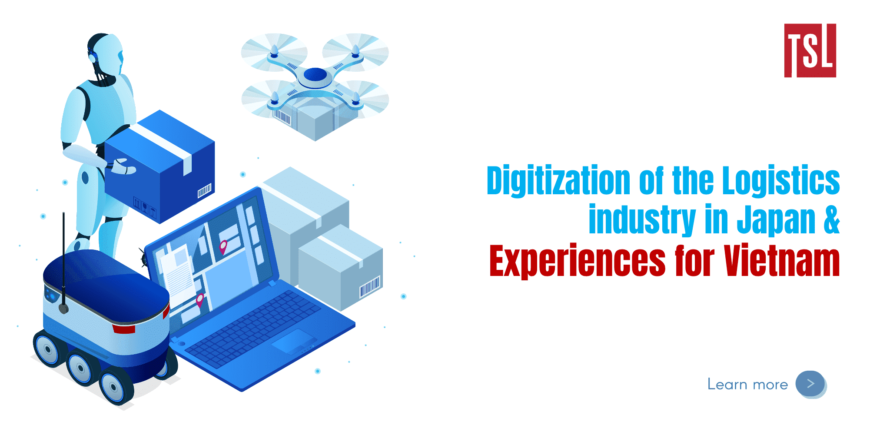Digitization of the Logistics industry in Japan and experiences for Vietnam
Driven by requirements to adapt to the context of the COVID-19 pandemic, the logistics industry in Japan is accelerating digitalization efforts even as disease prevention measures have been relaxed. Parties have been able to leverage technology to address a number of related challenges, from intra-logistics to B2B and last-mile logistics (business-to-end customer).
Logistics challenges and solutions through digitization
In the context of the so-called “global logistics crisis” since the outbreak of the COVID-19 epidemic in the world, logistics companies have to face many challenges in logistics, distribution and last mile services. As labor shortages worsen, labor-intensive solutions are reaching their limits and efforts to use technologies like AI and IoT have begun.
Specific analysis:
a) Segment 1: Intra-logistics
Problem
Shortage of warehouse workers: Although labor/warehouse workers shortages are as severe as truck drivers, labor costs for warehouse workers are also increasing (The national average minimum wage adjusted by region in 2017 was 848 yen, an increase of 25 yen). While truck rates are trending up due to a lack of drivers, warehouses have not made much progress in increasing wages, which is a factor pushing down the profit margins of warehouse operators.
Solutions through technology
Automatic warehouse: An automatic warehouse is a warehouse with a centralized management system for the entire process of product warehousing, from receiving, storing to shipping, which helps to reduce the number of workers needed for warehouse operations.
AGV (Automated Guided Vehicle): AGV refers to an unmanned vehicle for transporting products and parts in a factory or warehouse. In recent years, the use of AI and IoT in this field has increased, leading to significant growth and development of AGV. Through image recognition and machine learning, AGVs can run autonomously on irregular routes and analyze and optimize travel routes, and are becoming an effective solution for traffic routes. through day.
b) Segment 2: Logistics B2B
Problem
Truck driver shortage: While the volume of goods is increasing, the industry’s shortage of manpower continues due to influencing factors (declining birth rate, aging population and harsh working environment). harsh) exacerbates the driver shortage. The Japanese Ministry of Health, Labor and Welfare (MHLW) has set the working time for truck drivers in principle to 13 hours per day, with the possibility of extending this time to 16 hours depending on the situation. . They are also allowed to work no more than two 15-hour days per week, much longer than most companies’ eight-hour working hours. In addition, in recent years there has been an increasing number of cases where sellers claim to offer “free shipping” and it is assumed that this issue in improving service for consumers also has an impact. to a reduction in the driver’s wages.
Lower handling efficiency: Loading efficiency is the ratio of the weight of the cargo actually loaded to the maximum load weight of the truck. As transportation became more frequent with fewer workers, commercial truck loading efficiency continued to decline year over year and fell from 55% in the 1990s to about 40% in the 1990s. before the COVID-19 pandemic. With the growing shortage of truck drivers, improving delivery efficiency, including loading efficiency, is an urgent but complex task.
Solutions through technology
Delivery route optimization: Delivery planning assistance system that optimizes truck loading and driving routes when transporting goods can reduce delivery times for drivers and jobs create a new route.
Autonomous truck driving: As a solution to the truck driver shortage, research and demonstration tests for practical use of autonomous vehicles are underway. In particular, attention is being focused on a technology called “group driving,” in which multiple trucks work together in real time and automatically maintain a safe distance between them. Several companies in Japan have successfully demonstrated this technology on public roads and soon put it to practical use.
Demand Forecasting: To improve delivery efficiency, systems that predict future demand and sales volume based on past sales results and market trends are used. By forecasting demand and sales, it is possible to determine the minimum amount of inventory required at each location, which is effective in minimizing delivery losses and shortages. In recent years, services have also begun to emerge that use satellite imagery data to analyze store visits in a given commercial area, as well as customer demographics. and other factors to predict sales demand in retail stores.
c) Segment 3: Last mile (Business – Individual)
Problem
The deliverer and the receiver cannot meet, the goods must be delivered again next time, the goods do not arrive, exchange/return: According to a survey by the Ministry of Land, Infrastructure, Transport and Tourism, approx. 15% of total parcels are re-delivery. It is also estimated that 25% of driving distance is spent on re-delivery, which equates to 90,000 labor hours per year, which means about 180 million hours are spent on missed deliveries in a single year. year. While improvements have been made through the use of delivery boxes and promotion of same-day delivery, there is an urgent need to reduce the number of re-delivery and improve efficiency, as the EC market is expected to will continue to expand in the context of shortage of human resources.
Solutions through technology
Drone Delivery: One of the solutions to truck driver shortage and traffic congestion is to use drones for home delivery. Although it has yet to be put to practical use, companies like Amazon and Rakuten are conducting demonstration experiments. There are still hurdles to overcome in terms of safety, technology, and regulation, but the results of these trials are promising, such as Rakuten’s 2019 verification test in Chichibu City, prefecture Saitama, in which delivery drones flew out of view, in partnership with Tokyo Electric Power Holdings, Inc. and Zenrin.
The challenges of the logistics industry in recent years are driving the further adoption of digital technology and automation in the industry. The logistics crisis has also had a major impact on manufacturers, and it is important to view problems in the logistics network as a management priority, rather than leaving these issues to subsidiaries or distributors. logistics contractors undertake. In addition to considering the introduction of technology, it is effective to develop an optimal logistics system for the sales channel structure, such as considering procurement and inventory management and relocating facilities. logistics to prepare for fluctuations in demand.
*Source: VITIC, extracted from Japan, Korea logistics market report August 2022.








